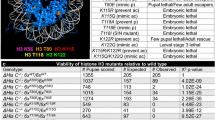Abstract
Expression of many mammalian genes is activated by the binding of heterodimers of the Myc and Max proteins to specific DNA sequences called the E-boxes. Transcription of the same genes is repressed upon binding to the same sequences of complexes composed of Max, Mad/Mxi1, the co-repressors Sin3 and N-CoR, and the histone deacetylase Rpd3. Max-Mad/Mxi1 heterodimers, which bind to E-boxes in absence of co-repressors, do not inhibit gene expression simply by competition with Myc-Max heterodimers, but require Sin3 and Rpd3 for efficient repression of transcription. We have cloned a Drosophila homolog of Sin3 (dSin3) and found it to be ubiquitously expressed during embryonic development. Yeast, mouse and Drosophila proteins share six blocks of strong homologies, including four potential paired amphipathic helix domains. In addition, the domain of binding to the histone deacetylase Rpd3 is strongly conserved. Null mutations cause recessive embryonic lethality.
Similar content being viewed by others
Author information
Authors and Affiliations
Additional information
Received: 28 April 1998 / Accepted: 8 July 1998
Rights and permissions
About this article
Cite this article
Pennetta, G., Pauli, D. The Drosophila Sin3 gene encodes a widely distributed transcription factor essential for embryonic viability. Dev Gene Evol 208, 531–536 (1998). https://doi.org/10.1007/s004270050212
Issue Date:
DOI: https://doi.org/10.1007/s004270050212




